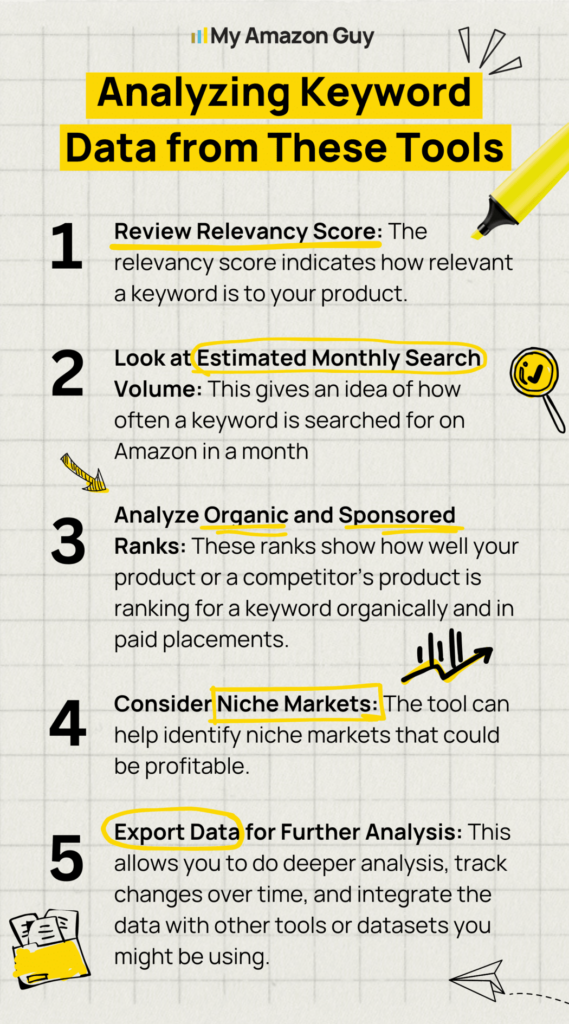Are you researching products to sell on Amazon? Before you proceed, review this guide to avoid the common product research mistakes sellers make.
When it comes to succeeding on Amazon, effective product research is crucial. However, many sellers encounter common mistakes that hinder their progress.
In this guide, we’ll reveal the product research mistakes sellers should avoid and provide actionable strategies to help you stand out in the competitive Amazon marketplace.
Learn how to refine your approach and make informed decisions that drive your business forward.
Mistake 1: Relying Exclusively on Data-Driven Tools
While data-driven tools like Jungle Scout and Zonguru are valuable for identifying trends and providing product insights, they should not be the sole determinant when selecting a product to sell. Relying solely on these tools for product research can lead to several issues.
Consequences of Overreliance on Data-Driven Tools
- Missed Opportunities: Focusing solely on numbers might overlook emerging trends or untapped niches.
- Increased Competition: Data-driven products often attract multiple sellers, leading to intense competition.
- Product-Market Mismatch: Products selected based solely on data might not align with actual customer needs.
The Solution
- Combine Data with Qualitative Research: Incorporate market research, customer feedback, and industry trends to gain a holistic view.
- Analyze Competition: Understand your competitors’ strengths and weaknesses to identify potential gaps in the market.
- Validate Product Ideas: Conduct market testing or surveys to gauge customer interest before investing heavily in a product.
Balancing product research tools with market intuition, consumer feedback, and industry knowledge ensures well-informed product decisions.
Mistake 2: Ignoring Customer Needs
Selling a product isn’t just a transaction; it’s solving a problem or fulfilling a need. It’s about focusing on how your product can address specific customer pain points rather than just pushing a generic item.
When you ignore your customer needs, you risk creating products and marketing messages that fall flat.
Consequences of Ignoring Customer Needs
- Low Conversion Rates: Products that don’t address customer problems are less likely to be purchased.
- Negative Customer Feedback: Customers who feel their needs are unmet are more likely to leave negative reviews.
- Missed Opportunities: Failing to identify unmet customer needs can hinder product innovation.
The Solution
- Conduct Customer Needs Assessments: Identify the problems customers are trying to solve.
- Prioritize Customer Pain Points: Focus on addressing the most critical issues.
- Create Customer-Centric Product Features: Develop products that directly address customer needs and desires.
- Gather Customer Feedback: Continuously seek input to refine product offerings.
Taking into account customer needs can be a game-changer. Aligning your products with customer needs can boost sales, enhance customer loyalty, and improve product development.
One strategy to align your offered products with customer needs is by creating complementary product bundles. By identifying products that naturally complement each other, you can cater to specific customer groups and increase average order value.
Amazon’s Virtual Bundles feature offers a convenient way to package and promote these complementary products. By strategically grouping items that address customer needs, you can enhance the overall shopping experience and drive sales.
Want to learn how to use Amazon Virtual Bundles? Check my 2024 video guide.
Mistake 3: Choosing a Niche You Know Nothing About
Opting for a product category or niche with which you have limited familiarity can be a major obstacle to selling successfully on Amazon. Choosing items in a niche you are passionate about or knowledgeable in allows you to make use of your expertise for product development, marketing strategies, and customer engagement.
Consequences of Limited Product Knowledge
- Difficulty in Product Differentiation: Lack of knowledge makes it challenging to identify unique selling points.
- Ineffective Marketing: Without understanding the product, creating compelling product descriptions and marketing materials becomes difficult.
- Poor Customer Support: Limited product knowledge can negatively impact the quality of customer service.
The Solution
- Become a Product Expert: Immerse yourself in the product category to gain a deep understanding of its features, benefits, and target audience.
- Conduct Thorough Market Research: Analyze competitors, customer reviews, and industry trends to identify opportunities.
- Seek Expert Advice: Collaborate with product experts or consultants to fill knowledge gaps.
Investing in acquiring product knowledge helps you position yourself as an authority in your niche and build a successful product line. To help you identify profitable niches, check Learn What to Sell on Amazon FBA for insights on the best products to sell on Amazon.
Mistake 4: Copying Other Sellers' Products
Imitating successful products without adding unique value is a shortcut to failure. This approach often leads to price wars, where profitability diminishes, and brand differentiation suffers.
Consequences of Copying Competitors
- Lack of differentiation: Copying competitors can make it difficult to establish a unique brand identity.
- Price Wars: Engaging in price competition can erode profit margins.
- Missed Opportunities: Focusing on imitation can prevent you from identifying untapped market segments or innovative product ideas.
The Solution
- Conduct Thorough Competitor Analysis: Identify competitor strengths and weaknesses to find opportunities for market gaps.
- Focus on Innovation: Develop unique products or services that address unmet customer needs.
- Build a Strong Value Proposition: Clearly articulate the benefits of your products and how they differ from competitors.
- Protect Intellectual Property: Take steps to safeguard your original ideas and designs.
By focusing on innovating—whether by improving existing products, offering new features, or creating entirely new products, you can differentiate yourself from the competition and attract a loyal customer base.
Mistake 5: Neglecting Keyword Research
Effective keyword research extends beyond identifying potential products; it includes optimizing your product listings for discoverability. Ignoring keyword research can significantly hinder your product’s discoverability.
Consequences of Neglecting Keyword Research
- Low Search Rankings: Products with poorly optimized keywords may struggle to appear in relevant search results.
- Decreased Visibility: Limited keyword usage can reduce your product’s overall visibility on Amazon.
- Lost Sales Opportunities: Failing to target relevant keywords can result in missed sales opportunities.
The Solution
- Conduct Thorough Keyword Research: Identify high-search volume, low-competition keywords relevant to your product.
- Optimize Product Listings: Incorporate carefully selected keywords into product titles, descriptions, bullet points, and search terms.
- Utilize Keyword Research Tools: Use tools like Helium 10 to identify potential keywords and track their performance.
- Monitor and Adjust: Regularly review and update your keyword strategy based on search performance and trends.
Prioritizing keyword optimization can improve your product’s search rankings, attract more potential customers, and increase sales.

Mistake 6: Ignoring Seasonal Product Trends
Understanding seasonal sales fluctuations is critical for Amazon sellers. Ignoring seasonal trends can lead to missed opportunities and inventory mismanagement.
Consequences of Ignoring Seasonal Trends
- Lost Sales: Failing to capitalize on peak sales periods can result in decreased revenue.
- Inventory Issues: Overstocking slow-moving items or understocking popular products can lead to financial losses.
- Ineffective Marketing: Marketing efforts may be misaligned with seasonal demand, reducing ROI.
The Solution
- Analyze Sales Data: Identify historical sales patterns to predict future trends.
- Adjust Inventory Levels: Optimize stock based on anticipated demand fluctuations.
- Implement Seasonal Marketing Campaigns: Create targeted promotions for peak seasons.
- Consider Seasonal Product Offerings: Expand your product line with seasonal items.
Carefully analyze seasonal trends and adjust your strategies accordingly to maximize sales and optimize your Amazon business.
Mistake 7: Failing to Understand Target Customers
Failing to understand your target customers can have severe negative consequences.
When you don’t know who you’re selling to, you risk creating products or marketing campaigns that don’t resonate with your audience, wasting resources, and losing customers to competitors who better understand their needs.
Consequences of Neglecting Customer Understanding
- Product-Market Mismatch: Products that don’t align with customer needs are less likely to succeed.
- Ineffective Marketing: Without a clear understanding of your audience, marketing efforts may be ineffective.
- Reduced Customer Satisfaction: Products that don’t meet customer expectations lead to dissatisfaction and negative reviews.
The Solution
- Conduct Customer Research: Gather feedback through surveys, interviews, and social media to gain insights into customer needs and preferences.
- Create Detailed Customer Avatars: Develop in-depth profiles of your ideal customers, including demographics, psychographics, behaviors, and pain points.
Building a detailed customer avatar is essential to understand your target audience deeply. This means going beyond basic demographics to grasp their preferences, pain points, and buying behaviors.
By truly understanding who your customers are and what they need, you can tailor your product offerings and marketing efforts to better resonate with them, thus enhancing your chances of success.
Don’t know where to start with building a customer avatar? Check my video guide on how to create an Amazon customer avatar to understand your customer demographics.
Key Points on Creating a Customer Avatar:
- Identify your product’s target audience.
- Create a visual representation of your ideal customer.
- Consider demographics, interests, and behaviors.
- Focus on specific details, especially for niche products.
Mistake 8: Overlooking Product Price Range Diversity
Knowing the product price range within a specific niche is crucial for successful product research. Focusing solely on low-priced products can hinder your ability to establish a profitable position in the market.
Consequences of Overlooking Price Range Diversity
- Limited Profit Potential: Concentrating on low-priced products may lead to lower profit margins.
- Increased Competition: Low-price segments often attract more competitors, making it challenging to differentiate your product.
- Missed Opportunities: Ignoring higher-priced segments can prevent you from tapping into a potentially lucrative market.
The Solution
- Analyze Price Distribution: Study the price range of top-selling products within your target niche.
- Identify Profitable Price Points: Determine where you can offer competitive pricing and maintain profitability.
- Consider Product Differentiation: For higher-priced products, focus on unique features, benefits, or quality to justify the premium.
- Diversify Product Offerings: Create a product line that caters to different price sensitivities.
Consider product price range diversity to improve your chances of finding a profitable niche and building a sustainable business.
Mistake 9: Neglecting Brand Strategy
Building a brand goes beyond selling products; it involves creating a brand identity that resonates with customers. Neglecting to develop a cohesive brand identity can hinder your ability to connect with your target customers.
Consequences of Neglecting Brand Strategy
- Lack of Brand Recognition: Without a distinctive brand identity, customers may struggle to remember your products.
- Reduced Customer Loyalty: A weak brand fails to foster trust and loyalty, leading to higher customer acquisition costs.
- Ineffective Marketing: Without a clear brand voice and messaging, marketing efforts become less impactful.
The Solution
- Develop a Strong Brand Identity: Define your brand values, personality, and target audience.
- Create Brand Guidelines: Ensure consistency in visual elements, messaging, and tone across all platforms.
- Tell a Compelling Brand Story: Connect with customers on an emotional level through storytelling.
- Measure Brand Performance: Track brand awareness, customer perception, and other relevant metrics.
Investing in a well-defined brand strategy builds a loyal customer base, enhances recognition, and improves overall business performance. Try building a unique brand narrative and customer experience that creates a cult following.
Tip: Consider developing brand guidelines as a blueprint to maintain consistent visual and messaging elements across all touchpoints. By defining brand attributes, color palettes, typography, and imagery, you can ensure a unified brand experience.
To know more about brand guidelines, check my video as I helped a client understand why brand guidelines matter.
Mistake 10: Underestimating the True Cost of Selling
Accurately calculating all expenses associated with selling on Amazon is crucial for long-term profitability.
Ignoring hidden costs can lead to financial setbacks. So take into account the true cost of selling when researching for products to sell on Amazon.
Consequences of Underestimating Costs
- Eroding Profit Margins: Neglecting to factor in all expenses can significantly reduce your profit margins.
- Misleading Financial Analysis: Inaccurate cost calculations can distort your financial performance, leading to poor decision-making.
- Cash Flow Problems: Unexpected costs can strain your cash flow, hindering business growth.
The Solution
- Comprehensive Cost Analysis: Conduct a detailed breakdown of all expenses, including product sourcing, manufacturing, shipping, storage, fees, marketing, and returns.
- Regular Cost Reviews: Continuously monitor and update your cost estimates to account for fluctuations.
- Profit Margin Analysis: Calculate your target profit margin and adjust pricing or expenses accordingly.
Thoroughly understand your costs to make informed pricing decisions, optimize your operations, and ensure the long-term viability of your Amazon business.
Mistake 11: Not Checking the Rules and Guidelines
Failing to thoroughly research and adhere to Amazon’s rules and guidelines can have severe consequences for your Amazon Seller Account. This includes understanding prohibited and restricted product categories.
Consequences of Ignoring Amazon's Rules
- Account Suspension or Termination: Non-compliance can result in your Amazon seller account being suspended or terminated.
- Financial Penalties: Violations often lead to fines and fees imposed by Amazon.
- Damaged Reputation: Policy violations can harm your brand’s reputation and trust with customers.
The Solution
- Conduct Thorough Product Research: Ensure your products comply with Amazon’s category and product restrictions.
- Regularly Review Amazon Policies: Stay updated on prohibited and restricted product categories.
- Utilize Amazon’s Product Lookup Tool: Verify product eligibility before listing.
Strictly complying with Amazon’s guidelines can protect your business, maintain a good seller reputation, and avoid costly mistakes.
Mistake 12: Not Monitoring Market Trends and Shifts
Staying updated with market trends is essential for long-term success on Amazon. Failing to adapt to changing consumer preferences can lead to declining sales and missed opportunities.
Consequences of Ignoring Market Trends
- Decreased Product Relevance: Products that don’t align with current market trends may become less appealing to customers.
- Reduced Sales: Outdated products may experience declining sales and profitability.
- Missed Opportunities: Failing to identify emerging trends can prevent you from capitalizing on new market opportunities.
The Solution
- Conduct Regular Market Research: Stay informed about industry trends, consumer preferences, and competitor activities.
- Analyze Sales Data: Identify patterns and trends in your product performance.
- Adapt Product Offerings: Modify existing products or introduce new products to align with market demands.
- Monitor Customer Feedback: Pay attention to customer reviews and feedback to identify emerging trends.
Staying ahead of market trends can ensure your product offerings remain relevant and competitive.
Master Your Product Research for Amazon Success
Mastering product research is essential for long-term success on Amazon.
Avoiding common product research mistakes is crucial for standing out on Amazon. Remember, product research is an ongoing process that requires continuous adaptation to market changes.
Need help with your product research? Contact our Amazon agency today for expert support.









